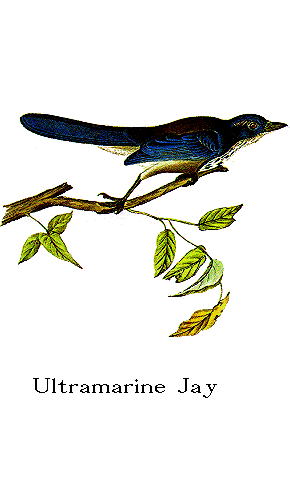Birds of America
By John James Audubon, F. R. SS. L. & E.
VOLUME IV.



Family
Genus

ULTRAMARINE JAY.
[Scrub Jay (see also Florida Jay).]
GARRULUS ULTRAMARINUS, Bonap.
[Aphelocoma coerulescens.]

PLATE CCXXXII.--ADULT MALE.
Although the Ultramarine Jay has been described by Mr. SWAINSON, in his
Synopsis of the Birds of Mexico, under the name of Garrulus sordidus, I retain
the specific name "ultramarinus," previously given by the Prince of MUSIGNANO.
The only observations respecting its habits that I am aware have been made, are
the following, for which I am indebted to my friend THOMAS NUTTALL.
"Early in October, on arriving in the forests of the Columbia, near Fort
Vancouver, an establishment of the Hudson's Bay Company, we saw in the same
situations with the Steller's Jay, the present species. Its habits are much
like those of the Common Jay. It usually flies out to the tops of the lofty
pines, jerks its tail, and perches playfully on some extreme branch, where it
utters at times, as if excited by petulant anger, a strong whoit, woit, woit,
woit, after which expression it emits a sort of recognition-call at short
intervals, twee, and sometimes a shorter 'twee 'twee. When much pursued, it
sits still in the concealing shade of the lofty branches on which it seeks
refuge. It feeds on insects, acorns broken up, and probably pine seeds. They
appear to associate in roving families throughout the fall and winter, like the
other species, seldom if ever associating with the more Common Steller's Jay,
though now and then perhaps in the same tree. It is a graceful, active, and
rather shy species, flying out straight from tree to tree, remarkable by its
long tail and rather short wings; and its note is much less harsh and loud than
that of Steller's Jay. They breed in the dark pine woods, probably, where we so
frequently saw them alight, and on the 15th of June they were feeding their
fully fledged young, two of which I pursued for some time, but they skulked so
effectually as to escape me after a long and doubtful chase. The young had a
great predominance of grey on the back. The same species also extends into
Upper California."
GARRULUS ULTRAMARINUS, Bonap. ULTRAMARINE JAY.
ULTRAMARINE JAY, Corvus ultramarinus, Aud. Orn. Biog., vol. iv. p. 456.
Bill shorter than the head, strong, straight, compressed toward the end;
upper mandible with the dorsal line declinate and convex toward the end, the
sides sloping and becoming convex toward the tip, which is declinate, thin-edged
and obtuse, the edges sharp and overlapping, with a slight notch; lower mandible
straight, the angle rather short and broad, the dorsal outline ascending and
slightly convex, the sides convex, the edges sharp and directed outwards, the
tip narrow. Nostrils basal, roundish, covered by the reversed bristly feathers.
Head large, ovate; eyes of moderate size; neck rather short; body compact.
Legs of moderate length, strong; tarsus much compressed, with seven large
anterior scutella, and two long plates behind, meeting so as to form a sharp
edge. Toes stout, with large scutella, the outer adherent as far as its second
joint to the middle toe; first very strong; inner toe shorter than outer, third
much longer. Claws strong, arched, compressed, acute.
Plumage full, soft, blended. Stiff feathers with disunited barbs over the
nostrils, the longest scarcely extending to a third of the length of the bill;
at the base of the upper mandible several longish slender bristles. Wings of
moderate length, convex, and much rounded; the first quill very short, an inch
and two-twelfths shorter than the second, which is eight-twelfths shorter than
the third, the fourth three-twelfths longer than the third, and a twelfth and a
half shorter than the fifth, which is the longest, but scarcely exceeds the
sixth. Tail long, much rounded, of twelve rather narrow, rounded and acuminate
feathers, of which the lateral is an inch and a quarter shorter than the
longest.
Bill and feet brownish-black. Iris hazel. Upper part of the head, sides
and hind part of the neck, wings, upper tail-coverts, and tail, light blue; back
light greyish-brown, the feathers of the rump whitish and tinged with blue at
the end; the inner webs of the quills dusky; the tail transversely undulated,
and having the appearance of being faintly barred with a darker tint. A white
band over the eye formed by the tips of the feathers there; the cheeks dusky;
the fore neck greyish-white, faintly streaked with dusky; and bounded below by a
narrow semilunar band of light blue continuous with that of the neck. The lower
parts are pale purplish-grey, passing into white on the abdomen; lower
tail-coverts tinged with blue.
Length to end of tail 12 inches; bill along the ridge 1 (1 1/2)/12, along
the edge of lower mandible 1 4/12; wing from flexure 5 8/12; tail 6 2/12; tarsus
1 8/12; hind toe (7 1/2)/12 its claw 7/12; middle toe 1 1/12, its claw
(6 1/2)/12.
The female is considerably smaller, but resembles the male in colour.
Length to end of tail 11 1/2 inches; wing from flexure 5 3/12; tail 6 2/12;
tarsus 1 7/12; middle toe 1, its claw (6 1/2)/12.
The resemblance which this species bears to the Florida Jay is so close
that one might readily confound the two. That species, however, is
distinguishable by its smaller size and its more rounded tail; by its having a
band of whitish across the forehead and extended over the eye, where it is not
in dots as in the Ultramarine Jay.









